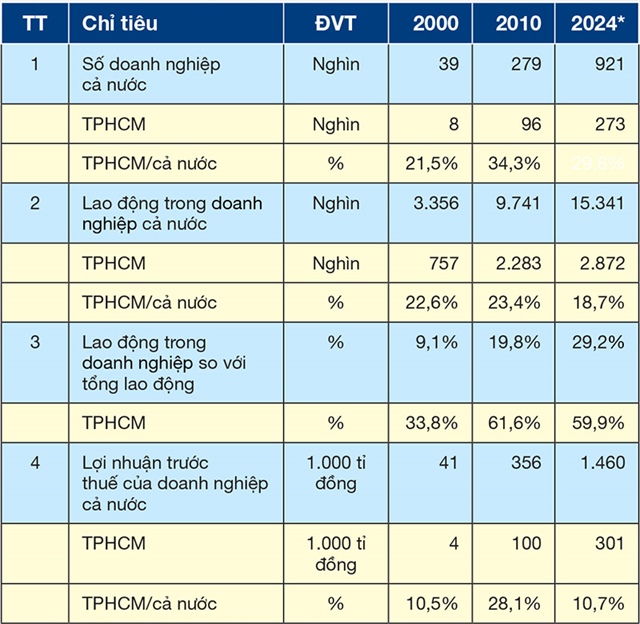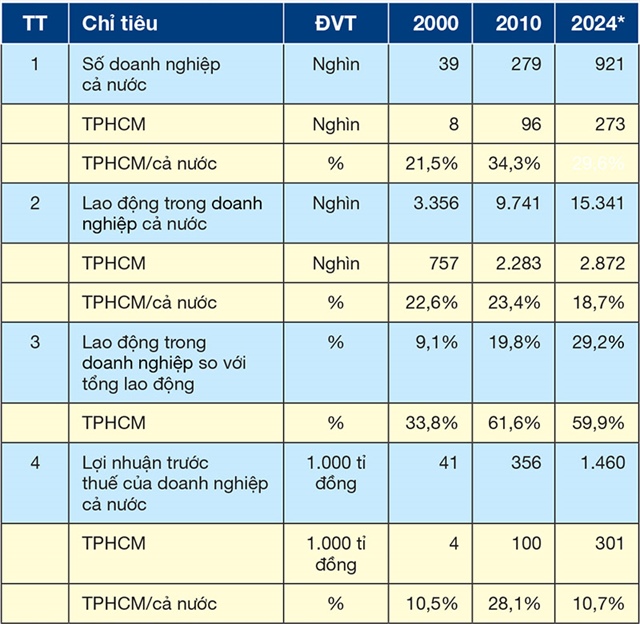Unleashing Private Sector Growth: Embracing a New Mindset for a New Era
Embracing Innovation: Vietnam’s Private Sector Resolutions for a Global Future
Vietnam’s Private Sector: A Driving Force Towards High-Income Status by 2045
Ho Chi Minh City’s Private Enterprises: Overcoming Challenges for Regional Prosperity
Ho Chi Minh City must address key bottlenecks to foster a thriving business environment and propel the region towards prosperity.
Slipping Economic Position of Ho Chi Minh City
While Ho Chi Minh City has maintained its position as Vietnam’s economic powerhouse for the past five decades, its growth trajectory is faltering. From 2010 to 2024, the city’s GRDP growth rate ranked 60th in the country, with GRDP per capita, labor productivity, income per capita, and wage growth all lagging behind. (See Table 1 for details)
The city’s contribution to the national GDP has declined from 18.7% in 2010 to 15.1% in 2024. Similarly, its share of national exports has dropped significantly, from 43.2% in 2000 to 12.7% in 2024. (Refer to Table 1)
A Comparison of National and Ho Chi Minh City’s Business Landscape

Data as of 2024 or latest available year. Source: Author’s compilation from official statistics |
Ho Chi Minh City has identified four key industries: mechanics, electronics-information technology, chemical-rubber and plastics, and food processing. Despite their potential for high technology and value addition, the impact on the overall economy remains modest.
Additionally, the service sector, a key strength and focus area for the city, has grown at a slower pace than the national average. The city’s share of national service output has declined from 26.6% in 2010 to 24.1% in 2024, with a notable decrease in high-value-added services like finance, banking, and telecommunications.
Ho Chi Minh City’s Business Landscape: Falling Behind
While Ho Chi Minh City leads the nation in absolute terms for many indicators, the performance and growth of its business sector are relatively lagging. This is evident when comparing large corporations and listed companies in the city with their counterparts.
In the 2024 Fortune 500 list, Vietnam had 70 companies, with 30 based in Hanoi and 25 in Ho Chi Minh City. Among the top 10 Vietnamese companies, Hanoi accounted for six, while Ho Chi Minh City had only two. A similar trend is observed in the stock market: in 2010, Ho Chi Minh City-based listed companies accounted for nearly 50% of the market capitalization, profits, and employee income. However, these figures have dropped significantly in recent years, with the city now contributing only 32% of market capitalization, 34.7% of profits, 19.3% of employee income, and 24.3% of the total number of companies.
When compared to other leading urban centers in East Asia and Southeast Asia, Ho Chi Minh City’s businesses, especially the leading ones, fall behind in competitiveness. The city’s business community and economy have yet to bridge the gap with more advanced regional competitors.
Six Bottlenecks to Address
Entrepreneurs in Ho Chi Minh City must aspire to offer products and services on a regional and global scale. However, individual ambition is not enough; a supportive ecosystem is crucial for business development. Currently, there are significant bottlenecks at both the micro and macro levels, including business strategies, cluster development, the business environment, and the effectiveness of government services, infrastructure, and social welfare.
To unlock the city’s potential, the following challenges must be addressed:
1. Overcoming Fear: While it belongs to the past, the fear of unpredictable policies, anti-corruption campaigns, and bureaucratic hurdles still lingers among entrepreneurs. A clear and consistent policy framework that supports legitimate businesses is essential to fostering a confident and vibrant business environment.
2. Fostering Collaboration: Loose linkages and a lack of trust among businesses hinder collective growth. Business associations should play a more active role in promoting collaboration and mutual support, going beyond their current focus on corporate social responsibility.
3. Creating a Level Playing Field: Private enterprises, particularly domestic ones, often face disadvantages compared to state-owned and foreign-invested companies. High informal costs and regulatory burdens, as pointed out by Professor David Dapice, disproportionately affect medium-sized enterprises.
4. Enhancing Government Effectiveness: The city government’s efficiency and effectiveness in serving businesses fall short of expectations. Various domestic and international rankings (PCI, PAPI, Par Index, Kearney, Innovation-cities) reflect this shortcoming. Additionally, the city’s retained budget is relatively low compared to its regional competitors and other localities.
5. Upgrading Technical Infrastructure: While technical infrastructure has improved in the past five years, it still needs enhancement to support a highly competitive economy, especially regarding connectivity, urban core infrastructure, and digital infrastructure.
6. Investing in Social Infrastructure: Social infrastructure has seen improvements, but skilled labor, innovative capacity, and educational standards lag behind regional peers. Both the hardware and software aspects of Ho Chi Minh City require significant upgrades.
In conclusion, while Ho Chi Minh City’s business sector has grown significantly over the past 50 years, it has not met expectations. The city lacks globally competitive enterprises, and fundamental bottlenecks persist across six critical components of business development. Addressing these challenges is crucial for businesses and the government to propel the region towards a more prosperous future.
Huỳnh Thế Du
The New Economic Frontier: Leading the Charge in Ho Chi Minh City’s Renaissance
Half a century has passed since the country’s reunification, and it has been a transformative journey for Ho Chi Minh City. The metropolis has always been vibrant and dynamic, witnessing and driving spectacular changes. Overcoming the challenges of the post-war era, the city has rapidly emerged as a major economic hub, solidifying its position as the nation’s leader.
“Ho Chi Minh City’s Reform Breakthrough: Asserting its Economic ‘Pioneer’ Status”
As Ho Chi Minh City embarks on a new phase of development, it faces not only a plethora of opportunities but also a slew of challenges. The city has begun to outgrow its infrastructure, resulting in bottlenecks that hinder its progress. To maintain its position as a vanguard, Ho Chi Minh City must embrace transformative reforms that match its expanding scale and ambition.
A Vision Proposal: ‘One Center, Three Corridors’ for Ho Chi Minh City’s Future Development
“The proposal to merge Binh Duong and Ba Ria – Vung Tau with Ho Chi Minh City to create a super-economic hub of Vietnam is a visionary move by the country’s leadership. To truly propel Ho Chi Minh City to new heights and unlock its full potential as the nation’s powerhouse, a bold and feasible long-term strategic vision is imperative. This vision transcends administrative boundaries, positioning Ho Chi Minh City at the heart of Vietnam’s economic development strategy. The article introduces the visionary concept of ‘One Center – Three Corridors’ for Ho Chi Minh City, aiming to fulfill this ambitious goal.”
The Pork Exchange: A $1 Billion Vision for Ho Chi Minh City’s Meat Industry
Ho Chi Minh City has the essential prerequisites to establish a pork trading floor and demonstrates the high feasibility of this model. With a daily consumption of approximately 10,000 pigs, the city’s annual expenditure on pork amounts to nearly VND 20 trillion.





















